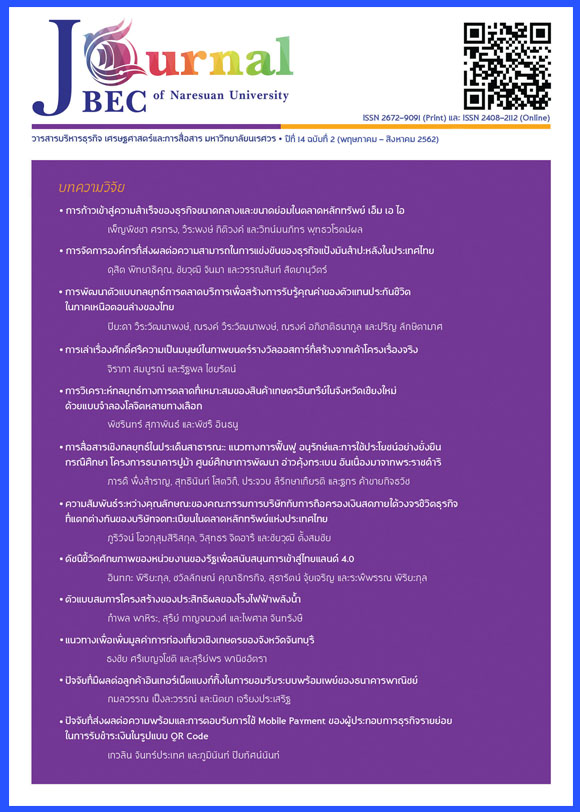Organization Management Affecting the Competitiveness of Tapioca Starch Businesses in Thailand
Main Article Content
Abstract
The purposes of this research are 1. To study present conditions of organization management of tapioca starch businesses in Thailand 2. To study the competitiveness of tapioca starch businesses in Thailand 3. To study the management factors that affect the competitiveness of tapioca starch businesses in Thailand by using quantitative research. The data were collected from 78 executives of tapioca starch businesses in Thailand. It equaled 83 percent of the total population. The instrument using in this research was a questionnaire and the data were analyzed using descriptive statistics, inferential statistics, percentage, average, standard diviation, corelation and multiple regression. The research found that 1. At present, using of management factors are at a high level in all aspects which are (from max to min) Structure, Strategy , Style of management, System, Shared values Skill and Staff. 2. The competitiveness of tapioca starch businesses in Thailand is at a high level in all aspects which are (from max to min) Quality of product, Cost leader, Customer response, Innovation and differentiation 3. Management factors that affect competitiveness of tapioca starch businesses in Thailand with statistically significance at the level of .05 are Strategy (β = 0.357) and Systems (β = 0.260). The change in the competitiveness of tapioca starch businesses in Thailand can be explained by using management factors consisting of Strategy and Systems at 44.8 % (Adj.R2 = 0.448).
Article Details
References
2. Colbert, J. C. (2010). Telework as part of a business continuity strategy: A path toward organizational resilience. Doctoral dissertation, Management, University of Maryland University College, Largo.
3. Dalf, R. L. (2006). Identification of the strategic planning process of small business in urban centers and the relationship with there performance. South-western: Thomson Corporation.
4. DeLoach, G. (2011). The genesis and evolution of dynamic organizational learning capabilities within the strategic product management process. Retrieved August 1, 2010, from https:// search.proquest.com
5. Du, S. M. (2010). Effect of digital enablement of business-to-business exchange on customer outcomes: The role of information systems quality and relationship characteristics. Retrieved August 1, 2010, from https://scholarworks.gsu.edu
6. Hackett, M. W. (2012). IT project portfolio management in telecommunications organizations: Strategic decision making in turbulence. Minneapolis: Capella University.
7. Hair, J. F., Black, W. C., Babin, B. J. and Anderson, R. E. (2010). Multvariate data analysis: A global perspectivc (7th ed.). New Jersey: Pearson education Inc.
8. Jutaratatkul, J. (2013). Business situation cassava. Retrieved April 25, 20016, from https://115.31.159.2/agriculture
9. Kasorn, K. (2013). The effect of market and learning orientations on competitive capabilities of the Thai automobile industry. Master thesis, D.B.A., Dhurakij Pundit University, Bangkok.
10 . Larry, G. (2016). Managers. Retrieved August 25, 2017, from https:// hbr.org/1973/03/what-managers-think-of-participative-leadership
11. Miller, A. and Dess, G. G. (1996). Strategic management (2nd ed.). New York: McGrawHill.
12. Nunnally, J. C. (1978). Psychometric theory (2nd ed.) New York: McGraw-Hill.
13. Pattana, K. (2009). The guideline that lead to the efficiency of Ranong Provincial Administration Organization. Master thesis, M.P.A., Khonkaen University, Khonkaen.
14. Rattanaprakarn, C. (2012). The effect of firms’ competitive advantage creations on beyond sufficiency-economy consumption behavior. Master thesis, D.B.A., Dhurakij Pundit University, Bangkok.
15. Suvinijjit, K. (2015). A study of strategic management of business mass communication case study: Television channel via satellite spring news. Master thesis, D.B.A., Rattana Bundit University, Bangkok.
16. Thaitapiocastarch. (2016). Cassava flour industry. Retrieved April 25, 2016, from https://www.thaitapiocastarch.org/th
17. Truncale, J. P. (2011). Interpersonal skills of highly successful business owners in the graphic communications industry. Retrieved November 23, 2014, from https://apps.prsa.org/Intelligence
18. Van-Assen, M., Van den Berg, G. and Pietersma, P. (2009). Key management models: The 60+ models to know. Harlow: Prentice Hall, 8(3), 118-125.
19. Westermann-Behaylo., M. K. (2010). Relationship between corporate ethical climate and stakeholder management. Business and Society, 53(5), 714-746.
20. Woo, K. and Ennew, C. T. (2005). Measuring business-to-business professional service quality and it consequence. Journal of Business Research, 58(9), 1178-1185.


